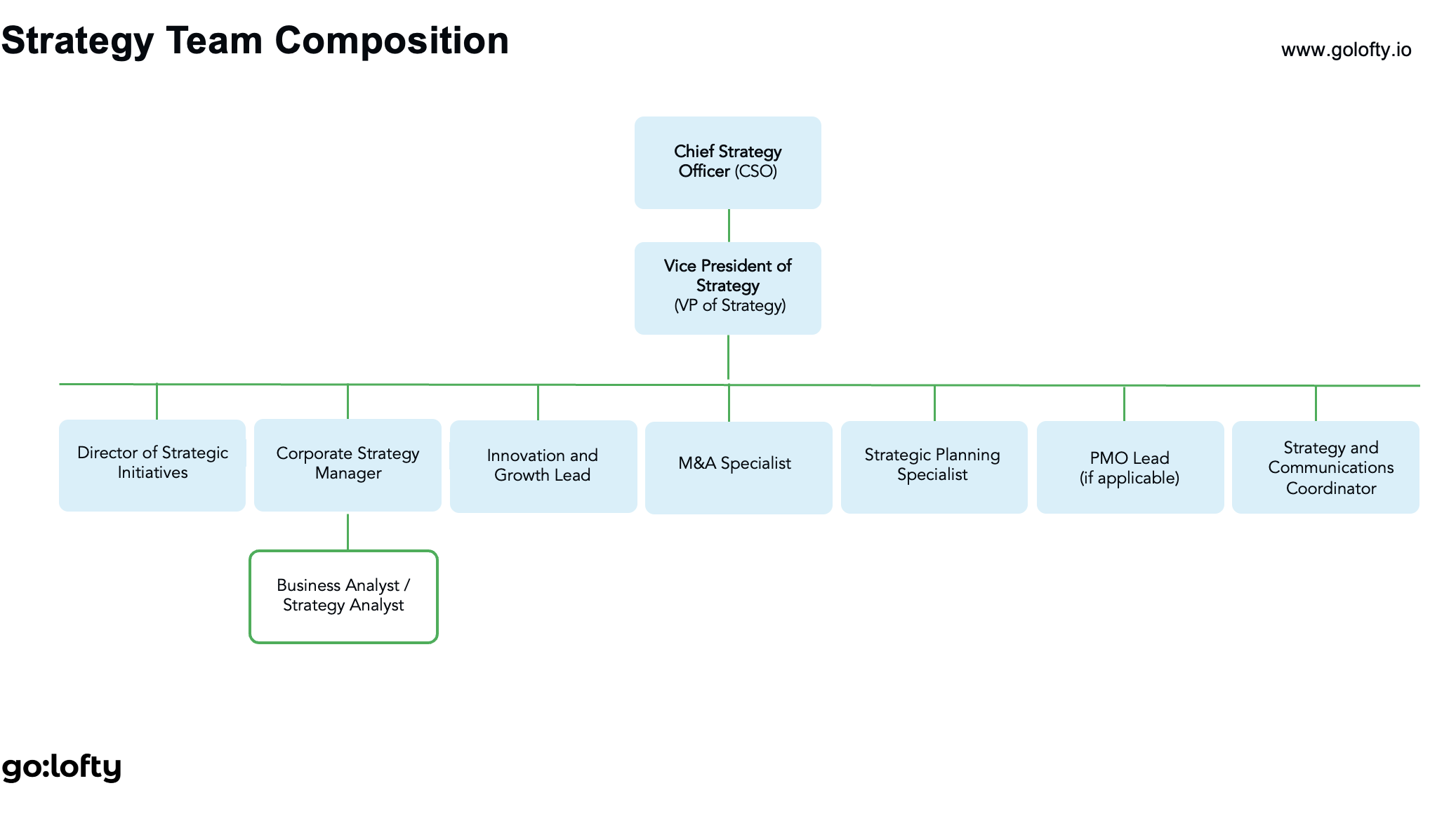
Building a Strategy Team: A Practical Guide for Establishing and Scaling Your Strategy Function.
In an increasingly complex and competitive business environment, having a dedicated strategy team is no longer a luxury—it’s a necessity. Whether your goal is long-term growth, navigating market shifts, or managing mergers and acquisitions, a well-structured strategy team can drive the success of your organization. But how do you establish a strategy team that delivers? What roles are essential, and how do you integrate this team into the broader corporate structure?
Let’s take a practical look at how to build a strategy team from the ground up, and the pivotal role this team plays in aligning your company’s objectives with real-world execution.
The Chief Strategy Officer: Setting the Vision
At the helm of your strategy team sits the Chief Strategy Officer (CSO). The CSO is responsible for defining and driving the overall strategic direction of the organization. In most cases, this individual works closely with the CEO and other members of the C-suite to ensure that the company’s strategic initiatives are aligned with long-term business goals.
The CSO’s role is broad and multifaceted. They not only oversee the strategy formulation process but also manage the implementation of strategic initiatives. They are often responsible for identifying new business opportunities, evaluating market trends, and even leading high-level decisions regarding mergers, acquisitions, and divestitures.
One of the most important qualities of a strong CSO is their ability to think both analytically and creatively. In a world that is constantly evolving, the CSO must guide the organization through uncharted territories, from technological innovations to shifting customer demands.
Supporting Leadership: The VP of Strategy and Strategic Initiatives
To support the CSO, most organizations also bring in a Vice President (VP) of Strategy. The VP of Strategy often acts as the right-hand person to the CSO, overseeing the execution of strategic initiatives and providing leadership to various strategic projects. In this role, the VP ensures that long-term plans are broken down into actionable steps.
In addition, a Director of Strategic Initiatives can be instrumental in ensuring that cross-functional projects align with business objectives. The director serves as the bridge between strategic vision and execution, leading project management efforts and working closely with different departments to guarantee that strategic goals are met on time and within budget.
Strategy Development: The Corporate Strategy Manager
Any successful strategy team requires analytical depth, which is why the Corporate Strategy Manager plays a vital role. This individual is responsible for conducting thorough market research, analyzing internal and external data, and making recommendations to the CSO and senior executives. Whether it’s assessing industry trends or identifying new business opportunities, the corporate strategy manager provides the insights that shape the company’s long-term strategy.
Equally important is the Business Analyst (or Strategy Analyst). This role provides critical data analysis to inform decision-making processes. Whether conducting a SWOT analysis or preparing presentations for key stakeholders, the analyst’s work ensures that the strategy is grounded in real-world data.
Innovation and Growth: The Path to Staying Competitive
No strategy team is complete without a focus on innovation and growth. The Innovation and Growth Lead is responsible for fostering a culture of innovation within the organization. This individual stays ahead of emerging technologies and trends, ensuring that the company remains at the cutting edge of its industry.
As organizations face ever-growing competition, innovation is no longer optional—it’s essential for survival. The Innovation and Growth Lead may also coordinate external innovation programs, such as partnerships with startups or collaborations with incubators, to continually push the envelope and explore new market opportunities.
Mergers, Acquisitions, and Strategic Planning: Shaping the Future
In many industries, growth doesn’t just happen organically. The Mergers and Acquisitions (M&A) Specialist plays a crucial role in evaluating potential acquisition targets and managing joint ventures. M&A activities are complex, and having a specialist dedicated to these initiatives ensures that the organization can grow strategically and sustainably.
Alongside the M&A specialist, the Strategic Planning Specialist focuses on the bigger picture. They manage the annual strategic planning cycle, facilitating workshops and cross-functional team discussions to ensure that every department is aligned with the company’s long-term goals. This individual also develops frameworks that make strategic planning more efficient and effective.
Communication is Key: The Strategy and Communications Coordinator
One of the most overlooked yet vital roles within a strategy team is the Strategy and Communications Coordinator. This individual ensures that strategic initiatives are communicated clearly across the organization. From preparing presentations to facilitating cross-departmental discussions, the coordinator ensures that everyone is on the same page, from top executives to frontline employees.
Without clear communication, even the best strategies can falter. The coordinator plays a key role in making sure that all stakeholders understand their role in the strategy, creating a unified approach to achieving organizational goals.
Project Management and Execution
Finally, many strategy teams benefit from having a Project Management Office (PMO) Lead to track the progress of strategic projects. The PMO Lead oversees the project managers responsible for specific initiatives, ensuring that every project aligns with the company’s broader objectives. This role is crucial for maintaining focus, tracking key performance indicators (KPIs), and ensuring that strategic deliverables are completed on time.
Building a Strategy Team that Delivers
So, what does it take to build a successful strategy team? Start by defining the roles that align with your organization’s goals. For larger companies, this may mean establishing specialized roles like an M&A specialist or Innovation Lead. Smaller organizations may opt for a more streamlined structure, combining some of these functions into a smaller group of key players.
The key to success lies in flexibility and adaptability. Your strategy team should be equipped to navigate both high-level corporate decisions and the day-to-day realities of business operations. As the business environment evolves, so too must your strategy team. This means regularly reviewing roles, responsibilities, and skill sets to ensure the team can meet new challenges head-on.
At the end of the day, your strategy team is the engine that drives your company forward. With the right mix of leadership, innovation, data analysis, and communication, your team can ensure that your organization not only stays competitive but leads the way in your industry.
More resources here




